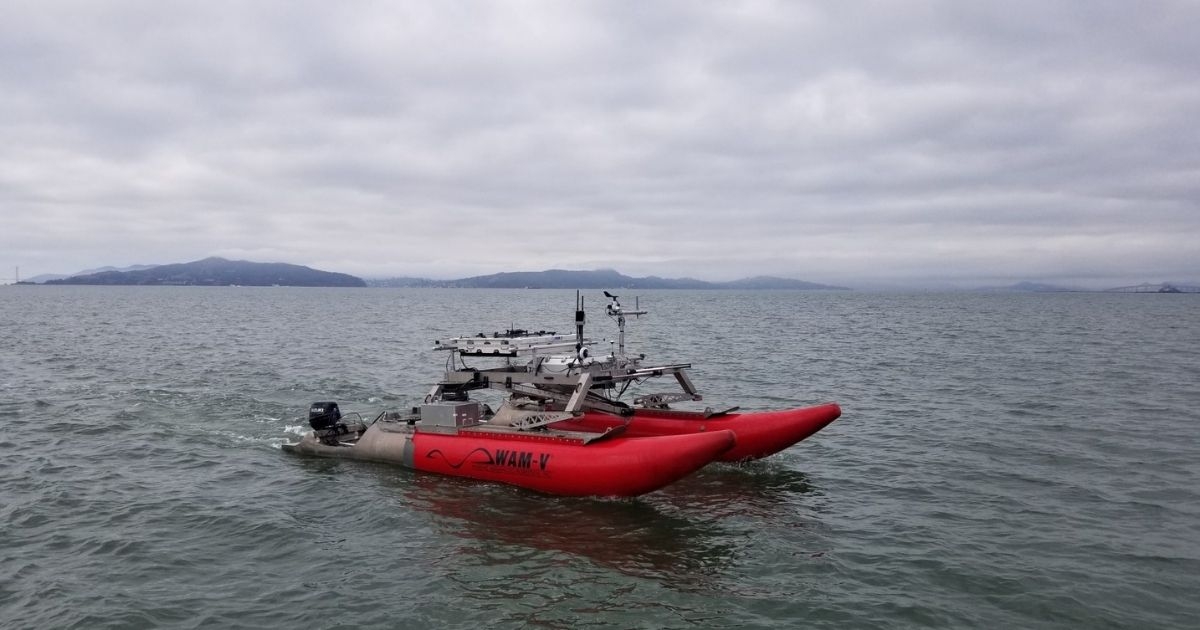DOE Funding Will Support WHOI Research to Support Sustainable Development of Offshore Wind

The Woods Hole Oceanographic Institution (WHOI) has received $750,000 in funding from the U.S. Department of Energy (DOE) to develop next‐generation autonomous robotic technology for environmental monitoring of marine organisms and the seafloor at potential wind energy development areas on the U.S. West Coast.
In addition, WHOI is part of a consortium on another project, led by Duke University, which has received $7.5 million DOE to assess the risk that offshore wind development on the U.S. East Coast may pose to birds, bats, and marine mammals.
The DOE in October announced this funding to provide critical environmental and wildlife data to support offshore wind development. A joint goal of the Departments of Energy, Interior, and Commerce calls for developing 30 gigawatts of offshore wind by 2030.
For the project to develop next-generation autonomous robotic technology, the funding will enable the development of a fleet of minimally intrusive marine robots that are specifically designed to provide automated 24/7 observation of marine ecosystems at offshore wind power installation sites. In addition, the use of autonomous robotic technology will reduce costs by minimizing requirements for people to be present for on-site monitoring.
The proposed robotic system, which aims to improve ecosystem monitoring of offshore wind power installations above and below the water line, includes the coordinated use of three principal classes of autonomous platforms. The platforms are a next-generation autonomous underwater glider under development by WHOI, autonomous benthic drifters developed by the University of Sydney’s Australian Centre for Field Robotics (ACFR), and WAM-V (Wave Adaptive Modular Vessel) autonomous surface vessels (ASV) built by Marine Advanced Robotics.
The platforms will be equipped with a broad range of instrumentation, including active and passive acoustic, optical, lidar, radar, and chemical sensors that enable persistent autonomous observation of marine habitats and species that may be impacted by wind farms.
“These robots will be operated in coordination to intelligently observe key ecological conditions while minimizing environmental disturbance,” says Richard Camilli, associate scientist in WHOI’s Applied Ocean Physics and Engineering Department. “Among other capabilities, this will include automated detection and continuous monitoring of threatened and endangered species, including tracking the movement of individual organisms, their body condition, and foraging success. This information will provide a more accurate picture of environmental change and overall ecosystem health.”
“We are excited to partner with WHOI and ACFR to create a safe, scalable, cost-effective robotic system for continuous, non-intrusive scientific observation and monitoring of marine wildlife and coastal habitats,” says Mark Gundersen, president, and CEO of Marine Advanced Robotics. “With its endurance, maneuverability, and stability, the WAM-V ASV will provide the ideal surface platform to capture high-quality data. The combination of the WAM-V ASV with WHOI’s autonomous underwater glider (AUG) and ACFR’s autonomous benthic drifters (ABDs) will minimize ecological disturbance and provide efficient, persistent surface and subsurface monitoring.”
“Understanding and reducing the impacts of wind farms on the ecosystem is paramount for the sustainable use of offshore wind power,” says Camilli. “We will demonstrate a fleet of low-cost autonomous marine robots for persistent monitoring of sensitive habitats and ecosystem health at offshore wind power installations, regardless of weather.”
For the project led by Duke University, WHOI will develop and apply smart, low-cost acoustic recorders to track marine mammal presence, location, and behaviors around wind farm sites, according to Aran Mooney, Associate Scientist in WHOI’s Biology Department and principal investigator in WHOI’s Sensory Ecology and Bioacoustics Lab. WHOI and the lab are established experts in marine mammal acoustics and the effects of ocean noise on marine life, and have been studying and considering potential wind farm impacts to marine environments for nearly 10 years.
“We expect a lot of this renewable energy development in the next few years and carrying out construction and operation in the least intrusive way (or understanding the benefits, like new habitats) is vital for our marine ecosystem,” says Mooney. “I am excited to test out our new real-time acoustic sensor to detect the presence and track the behaviors of protected marine mammal species like right whales and humpback whales. We are applying AI to detect these animals when they make calls and to report back their presence. Right now, such sensors are few and far between. By making them cost-effective, we can deploy quite a few more and provide a more detailed way to monitor endangered species.”

